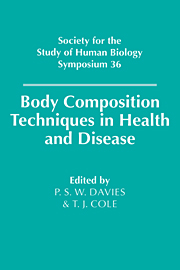Book contents
- Frontmatter
- Contents
- List of contributors
- 1 Application of dual-energy X-ray absorptiometry and related techniques to the assessment of bone and body composition
- 2 In vivo neutron activation analysis: past, present and future
- 3 Magnetic resonance imaging for the assessment of body composition
- 4 Multi-frequency impedance as a measure of body water compartments
- 5 Body composition assessed by electrical conductivity methods
- 6 Body composition in malnutrition
- 7 Influence of body composition on protein and energy requirements: some new insights
- 8 Prediction of adult body composition from infant and child measurements
- 9 Assessment of body composition in the obese
- 10 The role of body physique assessment in sports science
- 11 The assessment of the body composition of populations
- 12 Changes in approach to the measurement of body composition
- 13 Multi-compartment models for the assessment of body composition in health and disease
- 14 The future of body composition research
- Index
7 - Influence of body composition on protein and energy requirements: some new insights
Published online by Cambridge University Press: 18 September 2009
- Frontmatter
- Contents
- List of contributors
- 1 Application of dual-energy X-ray absorptiometry and related techniques to the assessment of bone and body composition
- 2 In vivo neutron activation analysis: past, present and future
- 3 Magnetic resonance imaging for the assessment of body composition
- 4 Multi-frequency impedance as a measure of body water compartments
- 5 Body composition assessed by electrical conductivity methods
- 6 Body composition in malnutrition
- 7 Influence of body composition on protein and energy requirements: some new insights
- 8 Prediction of adult body composition from infant and child measurements
- 9 Assessment of body composition in the obese
- 10 The role of body physique assessment in sports science
- 11 The assessment of the body composition of populations
- 12 Changes in approach to the measurement of body composition
- 13 Multi-compartment models for the assessment of body composition in health and disease
- 14 The future of body composition research
- Index
Summary
Introduction
A major development in recent years has been the introduction of new techniques and methods for the estimation of body composition (Kral & van Itallie, 1993). This is further illustrated by the varying and innovative methods that have been described in the previous chapters. In concert with these advances has been an interest in understanding the relationships between body composition on the one hand, and its impact on human biology and function on the other. The purpose of this chapter is to describe relationships between body composition and human nutrient requirements. In other words, we wish to explore the question: ‘Does body composition influence our protein/energy requirements?’ It is useful and indeed appropriate in human biology to examine protein and energy metabolism together for the following reasons: (1) protein metabolism, notably nitrogen balance, is profoundly influenced by energy balance, so that any perturbance in energy balance significantly alters protein metabolism (Calloway & Spector, 1954); (2) it is now conventional to express protein requirements as a proportion of total energy requirements, namely protein: energy percentage (P:E %) (Payne, 1975).
Historical background
It may be argued that Sarrus & Rameaux in 1839 were the first to suggest a link between energy metabolism and body composition, i.e. body size, when they proposed a relationship between heat loss and surface area. Following their lead, several classical physiologists such as Rubner (1883) and Richet supported this view and the principle was passed down as the ‘surface law of heat loss’. Further analysis and advances in measuring surface area in various animals led to the ‘surface law’ being questioned (Kleiber, 1932).
- Type
- Chapter
- Information
- Body Composition Techniques in Health and Disease , pp. 85 - 99Publisher: Cambridge University PressPrint publication year: 1995



